Seven Impossible Interviews Before Breakfast #40
(The One Shot World Tour: Best Read with Vegemite Edition) — Margo Lanagan
 August 15th, 2007 by Eisha and Jules
August 15th, 2007 by Eisha and Jules
 Welcome to 7-Imp’s stop in the first-ever One Shot World Tour, as organized by Colleen Mondor at Chasing Ray. The One Shot World Tour will involve approximately fifteen, more or less, blogs highlighting children’s and YA authors from different countries around the world — and all in one day for each stop (hence the “one shot” moniker). Today’s stop is Australia (and a bit of New Zealand). As author Margo Lanagan, our interviewee today (pictured above from a January ’07 visit to India), described it perfectly at her blog, Among Amid While, it’s an “Australian-themed children’s and teen literature multi-blog gabfest.” Today, each participating blog will post the master schedule of which blogs are talking about what books and which authors from Down Under (scroll down to the bottom of this interview to see the One Shot World Tour: Best Read with Vegemite schedule for today). Most bloggers will be talking up their favorite Australians writers/books, but a few blogs will be interviewing authors as well.
Welcome to 7-Imp’s stop in the first-ever One Shot World Tour, as organized by Colleen Mondor at Chasing Ray. The One Shot World Tour will involve approximately fifteen, more or less, blogs highlighting children’s and YA authors from different countries around the world — and all in one day for each stop (hence the “one shot” moniker). Today’s stop is Australia (and a bit of New Zealand). As author Margo Lanagan, our interviewee today (pictured above from a January ’07 visit to India), described it perfectly at her blog, Among Amid While, it’s an “Australian-themed children’s and teen literature multi-blog gabfest.” Today, each participating blog will post the master schedule of which blogs are talking about what books and which authors from Down Under (scroll down to the bottom of this interview to see the One Shot World Tour: Best Read with Vegemite schedule for today). Most bloggers will be talking up their favorite Australians writers/books, but a few blogs will be interviewing authors as well.
And we’re happy to be one of those blogs, because Australian author Margo Lanagan is gracing our site today. To call her “highly-acclaimed” does not even seem to do her justice. Lanagan is one of the most original and fascinating voices in YA literature today.
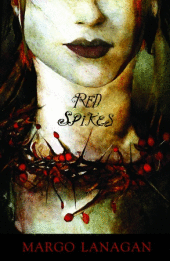 In case you are new to Lanagan, here’s our Margo Lanagan 101. Yes, we would be happy to evangelize her books to new readers . . .
In case you are new to Lanagan, here’s our Margo Lanagan 101. Yes, we would be happy to evangelize her books to new readers . . .
Her latest book (see our glowing co-review from just yesterday here at 7-Imp) is her third collection of speculative-fiction short stories, entitled Red Spikes, published in Australia by Allen & Unwin in October 2006. It will be published here in the U.S. by Knopf in October 2007. Stories from this collection have already been shortlisted for numerous awards, including the prestigious 2007 Frank O’Connor International Short Story Award (or so we read here, but don’t quote us on that, since there is this post at Lanagan’s site). You can also read this post at Lanagan’s blog, which includes more exciting news about Red Spikes. In our own review, Jules described what she thinks makes Langan’s writing stand out:
“What impressed me about all these stories and with her writing in general is her splendid power of observation… I don’t think a person could write this well without possessing that. Couple it with her command of the language (really, I wonder how long it takes her to so carefully construct these amazing stories?), and it’s like no writing I’ve read before. Lanagan is truly a singular and — dare I say (I risk seeming hyperbolic again) — extraordinary talent.”
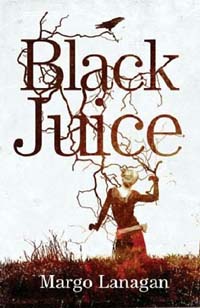 Before Red Spikes, Lanagan wrote a long list of children’s and YA fiction titles (which she addresses in the third question below), but only three have been published here in the States.
Before Red Spikes, Lanagan wrote a long list of children’s and YA fiction titles (which she addresses in the third question below), but only three have been published here in the States.
Black Juice, Lanagan’s debut book here in North America (published in Australia in 2004 and by HarperCollins/Eos in the U.S. in ’05), was named a 2006 Printz Honor Book, an ALA Best Book for Young Adults, and Best Collection in the Ditmar Awards; won two World Fantasy Awards; and received the Victorian Premier’s Literary Awards Prize for Young Adult Fiction, a Golden Aurealis Award for Best Young Adult Short Story, and a Bram Stoker Award nomination from the Horror Writers Association. School Library Journal wrote about this short-story collection: “Every selection in this rich collection is strange and startling, a glimpse into weird, wondrous, and sometimes terrifying worlds . . . Lanagan uses beautiful, lyrical language to tell peculiar, disturbing tales . . . This book will satisfy readers hungry for intelligent, literary fantasies that effectively twist facets of our everyday world into something alien.” And Booklist wrote, “{e}ach selection is carefully crafted and uses both familiar and inventive language to such intriguing effect that English teachers may want to incorporate the stories into classroom writing exercises.”

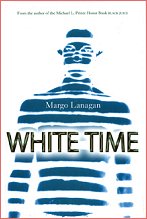 White Time (published here in the U.S. by HarperCollins/Eos in 2006), a collection of ten short stories, was also met with numerous favorable critical reviews. “Taut, vivid, original: another winner,” wrote The Horn Book, and Booklist wrote: “Further showcasing her mastery of the craft, each story underscores Lanagan’s talent for inspiring curiosity, disturbing sensibilities, and provoking thought.” Across The Pond, it was honored with the 2000* Aurealis Awards for Excellence in Australian Speculative Fiction (“The Queen’s Notice” won the Aurealis Best Young Adult Short Story Award) and more.
White Time (published here in the U.S. by HarperCollins/Eos in 2006), a collection of ten short stories, was also met with numerous favorable critical reviews. “Taut, vivid, original: another winner,” wrote The Horn Book, and Booklist wrote: “Further showcasing her mastery of the craft, each story underscores Lanagan’s talent for inspiring curiosity, disturbing sensibilities, and provoking thought.” Across The Pond, it was honored with the 2000* Aurealis Awards for Excellence in Australian Speculative Fiction (“The Queen’s Notice” won the Aurealis Best Young Adult Short Story Award) and more.
In a review of White Time here at 7-Imp, Eisha praised her general style:
Like some of Bradbury’s work, Lanagan specializes in speculative fiction – “what if?” stories. Stories set in worlds that are almost just like ours, but with a little sci-fi twist, a supernatural tweak. And with her utterly original “what if” scenarios… Lanagan deftly explores the complex terrain of the human psyche.
*{If that 2000 award date for White Time confuses you, the Booklist review stated that it was actually published abroad several years before Black Juice}.
And, lucky for us all, Lanagan keeps us up-to-date on her writing at her blog, the aforementioned Among Amid While. Currently, Lanagan is working on a fantasy novel called Tender Morsels, which will be published in Australia by Allen & Unwin, “probably in August 2008,” she states in this post. In fact, she shared at the blog that the novel is currently going through its final check before being sent to four different publishers and that this “feels like a cross between sending someone into a dark alley to be beaten up, and sending them into a brightly lit operating theatre where they will be carefully dismembered.” (We wish her luck in keeping herself occupied during that process! It can’t be easy) . . .
It’s truly an honor for us to have had the opportunity to interview Margo Lanagan on our humble little blog, and we thank her for taking the time to talk to us.
*And for more a little more Margo, don’t forget to check out Shaken and Stirred today – Gwenda is also featuring her for the One Shot World Tour.*
7-Imp: Have you always wanted to be a writer, or was there an event or series of events that flipped the writer-switch on?
Margo: I didn’t realise I was allowed to be a writer until my mid-twenties when I started being an editor, and editing all the other people who’d become writers, and finding lots to fix. I’d always written, and I’d had some poetry published, but being a writer had looked, from the outside, a bit like being an astronaut, or being a movie star. I decided I wanted to write and publish novels, with the ultimate aim of making a living from that.
7-Imp: Which writers have had the greatest influence on your work?
Margo: Oh gee, recently, George Saunders, Michael Cunningham, and Holly Black, whose book Tithe is directly responsible for me allowing myself to have so much fun writing the novel I’m writing. In the long-term, Alan Garner, William Mayne (yes, I know about the gaol term), Russell Hoban, Anne Tyler, Patricia Wrightson, Tove Jansson and . . . I could go on forever.
7-Imp: Only three of your works have been published in the U.S. so far. Can you tell us a little about the ones we’re missing?
Margo: You’re missing about ten teenage romances — no great loss. And three junior fiction titles (each with a fantasy element): Wildgame, The Tankermen, and Walking Through Albert. And two YA novels: The Best Thing (teenage pregnancy and boxing) and Touching Earth Lightly (teenage murder and creativity). Also, two series fantasy novels, Treasure Hunters of Quentaris and The Singing Stones, although no one in Australia has seen that last one either yet—it’s coming out in September. {Ed. Note: See the Singing Stones cover here at Lanagan’s blog}.
7-Imp: Please tell us about your decision to attend Clarion West, after you’d already become a published writer.
Margo: It was a cry for help! No, not really. I’d decided several years earlier that I was going to write fantasy. Then I had laboured, yes, for about three years, on a huge, unwieldy, uncontrollable fantasy novel. I had dug myself a big hole and was floundering around in the mud at the bottom of it, hating the world. Then I saw the ad for Clarion West 1999 in one of the first Locus magazines I ever bought, and really, I applied because I wanted to run away from the novel, and short stories sounded so wonderfully, well, short! And manageable. And they were, and I published nothing but short stories for the next seven years! Oh, except for the Quentaris novel.
7-Imp: When we interviewed Sonya Hartnett, she mentioned her struggle with the YA label imposed on much of her work by publishers and the “general scorn” that Australian children’s/YA writers endure in their own country. Do you intentionally write for children and young adults, or is that more of a label that’s been applied to your writing by others? And how do you feel about the children’s/YA writing industry in Australia — are writers for young readers treated with less respect, given less money, etc.?
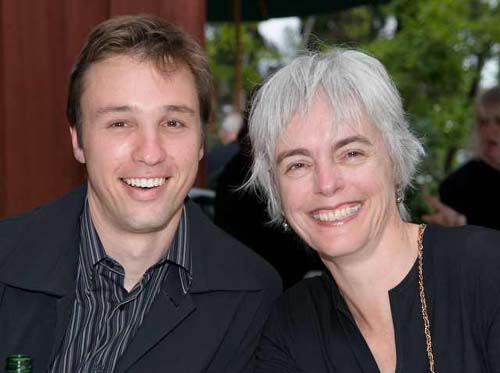
the L.A. Times Book Prize ceremony}
Margo: I don’t think the “general scorn” is directed specifically at Australian children’s and YA writers. I think any writer cops it here. Unless s/he is also a sportsperson. *rolls eyes* Or a bestseller — the making of pots of money covers a multitude of sins! Sometimes I’ve intentionally written for children and young adults, but nowadays I tend to write whatever coughs itself up from inside me, without worrying about who it’s for. And if too much sex or darkness comes up, I publish it in an adult market (this has only happened for short stories so far) and otherwise it gets published for young adults.
The only time writers for young readers get less respect is at writers’ festivals, when we tend to get hived off to school-age audiences and kept away from the adults generally, which gets annoying after a while. Otherwise, I think we’re better distributed and better paid, certainly than adult literary-mainstream authors, because school libraries and parents tend to buy us, as well as the occasional teen! But Australia isn’t the most child-friendly culture, I don’t think (unless the child is a sportsperson *rolls eyes again* or, again, horribly rich), so anything associated with children tends to be rather looked down on generally, so we’re part of that.
In the office environments I’ve been working in for the last half-decade (manufacturing companies, insurance, banks, government departments etc.), if I’ve chosen to reveal that I write books (which I’ve generally found to be not a good idea), the usual reaction is that if I were writing for adults I’d just be extremely odd, but if I’m writing for children and teenagers, or writing speculative fiction, not only am I extremely odd, but (what a relief!) no adult should feel obliged to show any desire to find and read my books, although I may have helped them in the Christmas-gift stakes when it comes to nieces and nephews.
That’s okay, though—I’ve been odd for a long time, and I’m pretty used to it now.
7-Imp: Is there a difference in how your stories have been received in the U.S. vs. Australia?
Margo: Yes, the U.S. has been much more openly enthusiastic. I never thought of my own country as so wet-blanketish, until I went to the U.S. and had librarians pour bucketfuls of praise on my head. Oh my, that was nice. And I thought, Hmm, aren’t Australians restrained?
7-Imp: Since we’re sort of sharing you with Gwenda of Shaken & Stirred for this One Shot World Tour event, we’ll ask a Gwenda-like question: Tell us about your writing process (starting wherever you like: getting the idea, starting to write, under deadline, etc.).
Margo: Have you got a spare hour or two? I can talk process-porn until the cows come home — and I loved reading about everyone’s work habits in the Summer Blog Blast Tour, so keep asking, Gwenda!
I keep notebooks, where I collect bits of stuff that might be useful, also encouraging quotations. I write first drafts longhand, to avoid aggravating my RSI and becoming keyboard-dependent. This last novel I’ve been writing, I tried to fool myself (because I would otherwise have been too intimidated) that it was just a whole bunch of linked short stories, so I worked on this ‘collection’ awhile before sitting down, admitting it was a novel, and working out which other ‘short stories’ (i.e. chapters) I needed to turn it into a complete novel. Now I’m finishing those off, combing and combing through the word-processorscript, filling up all the white space and adding pages. I can neither compose nor edit on-screen – I need to see the full page I’m working on, and the size of the pile of pages either side of it.
I work either at my kitchen table at home, or in my rented writing room, which is a couple of blocks from where I live. I can also write on trains, in libraries, in cafes, and underwater – no, I’m still working on the underwater bit. I don’t write every day; when I’m ‘full-time writing’ (i.e. not doing any dayjob work) I’ll write weekday mornings and up until 2 o’clock, and try to do other stuff in the afternoons, like exercise, get out of the house, talk to other human beings, shop for dinner. Weeks can go by when I don’t write, especially if there’s a dayjob going, and I find that these fallow times are quite good for stopping me boring myself to sobs with my own ideas and habitual word choices. When I was writing the teen romances, I trained myself to write quite fast, though, so when I do sit down to write, I tend to get a lot down per session.

7-Imp: I (Eisha) thought “Red Nose Day” from Black Juice was possibly the creepiest short story I’d ever read — until I read “Winkie” in Red Spikes (in bed, right before sleep. Really unfortunate.). What does it do to you as a writer, and a human being, to create these stories? Is it easy to shake off once you step away from the pencil/keyboard, or do you really have to live with these characters for a while?
Margo: “Red Nose Day” started off as a post-it note saying ‘Snipers picking off clowns’, and I can’t remember the circumstances in which I wrote that down, but I have to say, I thought the idea was a complete hoot, being a clown-hater from way back, and I have been told by fellow clown-haters that the world is a better place for someone having given the idea so much airtime. In the end, of course, it got quite serious, when the clowns’ child abuse and its consequences came to light. I’m assuming you’re on the side of light and goodness, Eisha, and not on the side of the clowns? (Because if you’re on the clowns’ side, I’m afraid we must never speak again.)
“Winkie” is really about my own night terrors when I was a child, of people looking in the window, of monsters menacing me, of people creeping into our house and staring at us as we slept, that kind of thing. So I would say I have lived with that scariness for quite a long time, and used it to feed into the atmosphere of that story. But both the clown fear and the night-monsters fear are old fears that my rational self is pretty much on top of, so although I can use the remembered feelings, I don’t so much experience them these days.
And the satisfaction of putting together a story always outweighs the power of the material for me. Especially if it gives vent to a strong and usually unarticulated emotion, watching a story come into being is . . . well, really, it’s the best fun you can have on your own, clothed or not. I really feel quite cheerful, sometimes even exhilarated, when I’m writing dark stories. I’m not sure what this says about me . . .
7-Imp: You frequently choose to write stories from the point of view of animals (“Sweet Pippit,” “The Queen’s Notice,” “Monkey’s Paternoster”). What’s the appeal for you in writing these stories?
Margo: Stretching my brain around how another creature might perceive the world; putting animals in stories that don’t patronise them (well, I aim for them not to — some people might think just using animals in this way is patronising).
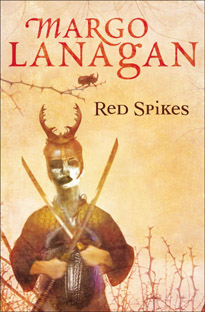 7-Imp: This wonderful May ’07 review of Red Spikes at Strange Horizons states: “Even more than Ursula K. Le Guin’s, Lanagan’s stories prioritise the powerless, the empty-handed, the dispossessed. She earths her violent and uncompromising imaginings in tactile and particular detail: in worlds built from the bottom up, from the rock and mud. They are felt and smelt by characters who are closest to the ground: children, servants, peasants, and animals.” Do you consciously set out to write about the powerless and dispossessed?
7-Imp: This wonderful May ’07 review of Red Spikes at Strange Horizons states: “Even more than Ursula K. Le Guin’s, Lanagan’s stories prioritise the powerless, the empty-handed, the dispossessed. She earths her violent and uncompromising imaginings in tactile and particular detail: in worlds built from the bottom up, from the rock and mud. They are felt and smelt by characters who are closest to the ground: children, servants, peasants, and animals.” Do you consciously set out to write about the powerless and dispossessed?
Margo: I never really thought of it in those terms — but since Colin Greenland wrote that, I keep noticing the POVs I tend to go for. I thought I was writing from viewpoints slightly to one side of the action, but yes, in fact the viewpoint is usually also slightly below the status level of the action, in whatever hierarchy is operating.
But no, I never set out consciously to write about the powerless and dispossessed. That makes me sound very committed and worthy, when in fact I’m a flibbertigibbet and a taker-of-one-bite-out-of-chocolates. 🙂
7-Imp: Why did you start a blog?
Margo: It was a form of writing I could sneak in at the day job. I was reading (inhaling, would be a better word) a lot of blogs at the time (July 2005), and it seemed like a sensible thing to have a presence on the Internet, but better suited technically to my abilities than maintaining a website. And Justine Larbalestier nagged me. If you’ve ever been nagged by Justine, you will know that’s a powerful inducement.
7-Imp: How does the blog support and/or interfere with your writing?
Margo: It doesn’t interfere at all; I rarely use time I should be writing in, to update it. It supports it, mainly because it reduces the loneliness of the long-term writer; I love touring blogs and reading about how other writers are keeping wordcounts and solving problems and hating or loving what’s coming out of them. Lately, I’ve been on the home stretch with this novel, and I’ve been blogging daily on my progress, or lack of. It’s a nice, non-threatening form of accountability. The coolest thing about it is meeting someone whose blog you’ve been reading for a while — instant conversation starter! I’m always up for those.
 7-Imp: What are you working on now?
7-Imp: What are you working on now?
Margo (pictured here at The Grand Canyon, May 2006): A gloriously fat (for me) fantasy novel called Tender Morsels. I’ll be handing this in to Allen & Unwin at the end of the month. They tell me it will be out (in Australia; I don’t know about the rest of the world) around August 2008. From here that seems like a long time, but when it happens, it will feel as if only three months have passed.
7-Imp: What three living authors would you like to have over for coffee/wine?
Margo: This question was too hard; I think I’m going to have to just have a street party and invite everyone.
7-Imp: We like to conclude our interviews by posing to people the weird and wonderful set of questions called The Pivot Questionnaire, since who knew that asking someone, say, what their favorite sound or noise is could tell you so much about them. So here goes:
What is your favorite word?
Margo: Judging by my current manuscript, “dark” and “great.” I’m very fond of “bewilderment” at the moment, too.
7-Imp: What is your least favorite word?
Margo: At the moment, “feisty,” which is always being used to cosify women’s bravery—-you never hear it applied to a man, unless he’s a little man, a gnome or a dwarf or a jockey. “Moist” is also bad. “Munch” is also bad. “Special” is hideous. “Passion” is a word I’m extremely tired of hearing.
7-Imp: What turns you on creatively, spiritually, or emotionally?
Margo: Staying in hotels (starred or not).
7-Imp: What turns you off?
Margo: Any kind of interpersonal conflict.
7-Imp: What is your favorite curse word? (optional)
Margo: “Buttery bugholes!”
7-Imp: What sound or noise do you love?
Margo: That kind of glick-glick-glick of wine being poured from a full bottle.
7-Imp: What sound or noise do you hate?
Margo: Talkback radio at any volume. Shouty advertising.
7-Imp: What profession other than your own would you like to attempt?
Margo: Something halfway useful in the medical profession.
7-Imp: What profession would you not like to do?
Margo: Any kind of tour guide.
7-Imp: If Heaven exists, what would you like to hear God say when you arrive at the Pearly Gates?
Margo: “Hang on, you’re not on my list. Oh, heavens, Margo, here you are down here! No-no-no-no-no, you’re not here for another twenty happy healthy years. Get back to Earth, woman!”
All photo credits here are by Steven Dunbar.
For more information on Margo Lanagan and her books:
- Among Amid While, Lanagan’s blog
- “Margo Lanagan turns attention to novels,” interview by Gary Kemble at Articulate; May 30, 2007
- Interview (podcast) by Grant Stone at Faster Than Light; May 23, 2007
- Margo Lanagan profile at Inside A Dog; 2006-2007
- “Margo on Writing” at the Allen & Unwin site; 2006
- “Black juice and good deaths,” interview by James Smith at The Story Story website; July 2006
- “Author mini-interview: Margo Lanagan” at Forbidden Planet International Blog Logs; April 20, 2006
- Interview excerpts from “Margo Lanagan: Essence of Elephants,” which was published in the June 2005 issue of Locus Magazine; 2005
- Interview by Ben Peek in the 2005 Snapshot at Tabula Rasa
- “A Conversation with Margo Lanagan,” an interview conducted by Trent Walters at The SF Site; August 2003
Today’s One Shot World Tour schedule:
- Betsy Bird at A Fuse #8 Production talks more about John Marsden and also highlights a new Hot Man of Literature: Andy Griffiths;
- Big A, little A writes about Anna Feinberg and her “Tashi” series;
- A Chair, a Fireplace & a Tea Cozy is all about Catherine Jinks and her four “Pagan” books;
- Chicken Spaghetti reviews Kathy Hoopmann’s award winning All Cats Have Asperger Syndrome;
- Colleen Mondor at Chasing Ray writes about Nick Earls;
- Finding Wonderland has a look at Undine by Penni Russon and a look at some of Jaclyn Moriarty’s titles;
- Gwenda at Shaken and Stirred is all about How Sassy Changed My Life, The Red Shoe by Ursula Dubosarsky, and a wee bit more with Margo Lanagan;
- Jackie at Interactive Reader posts about Randa Abdel-Fattah’s Does My Head Look Big in This? and John Flanagan’s The Icebound Land;
- Jen Robinson discusses John Marsden’s “Tomorrow” series;
- Jenn at not your mother’s bookclub interviews Simmone Howell;
- Jenny Davidson interviews mystery author Peter Temple;
- Kelly Fineman is all about Melina Marchetta;
- Little Willow discusses Finding Grace by Alyssa Brugman;
- MotherReader posts on Am I Right or Am I Right? by Barry Jonsberg;
- Trisha at The Ya Ya Yas interviews Queenie Chan.

[…] Seven Impossible Things Before Breakfast interviews Margo Lanagan […]
What an extraordinary interview! You can tell Margo is a generous author just from her answers to your questions, Eisha and Jules.
I love her least favorite words answer, as well. I agree with her completely on all of them.
Thanks, Kelly! She is indeed. And yeah, “moist” makes the worst-words-ever list for sure.
Kelly and Eisha, I found this yesterday. Funny stuff.
Oh, that is so funny. I love the notes “okay with arrowheads,” for example.
You know, when I read interviews like this from writers I admire, I feel so… good. Like, a.) there’s hope for famous people to still be cool b.) there’s hope for writers to not be all grumpy and backwards like I occasionally am, and… c.) stuff.
I don’t know. I think ‘generous’ was the best word. She’s so talented and so amazingly nice and accessible that I’m all buzzed.
This made my day. Great interview, grrrls!
Good reading, y’all. I’m with ML on “moist.” Ew, get it out of here.
So ditto on the glick-glick-glick sound. Fabulous interview, ladies!
These sound like my kind of books. I’ve put them on hold….
Oh, I’m so glad she’s having a street party! That means I can come too. Really, I’m with TadMack on this one. I was afraid because she’s such an extraordinary writer that I would find her process (thank you for talking process!) unattainable, but no, she kind of (ahem) does it like I do, with notebooks and tricking herself and all that. Only better. But still. I feel encouraged.
And she loves hotels! Me, too. Old ones, ritzy ones, glamorous ones…I always feel like some other person when I stay outside my home.
P.S. Eisha: if Winkie is scarier than Red Nose Day, I’m going to have to take a Valium before I read it. Yikes. I can’t believe that I LOVE her stuff, when I HATE all other scary books.
“Buttery bugholes!”
Still laughing at that. Great job, as always.
Thanks, ya’ll!
Sara, just make sure it’s daylight. You’ll be fine.
Fabulous interview. I love her book titles!
[…] (Vegemite and all) Australian meal were: interviews with Margo Lanagan and Queenie Chan at 7 Imp Things and the YA YA YAs, respectively, and an exploration of John Marsden’s Tomorrow Series at Jen […]
Could you help me. In all recorded history there has not been one economist who has had to worry about where the next meal would come from.
I am from Guatemala and now teach English, give please true I wrote the following sentence: “Zuora, a startup that builds software for companies to bill customers for online services, said tuesday.”
Thank you very much ;-). Kellie.
[…] Margo Lanagan’s Tender Morsels. Trippy, you guys. And so good, too. (And I’m just now seeing the man’s […]
[…] (Vegemite and all) Australian meal were: interviews with Margo Lanagan and Queenie Chan at 7 Imp Things and the YA YA YAs, respectively, and an exploration of John Marsden’s Tomorrow Series at Jen […]
[…] month, I talked with the talented Margo Lanagan over at Tennessee’s Chapter 16 about collaborating with Scott Westerfeld and Deborah […]